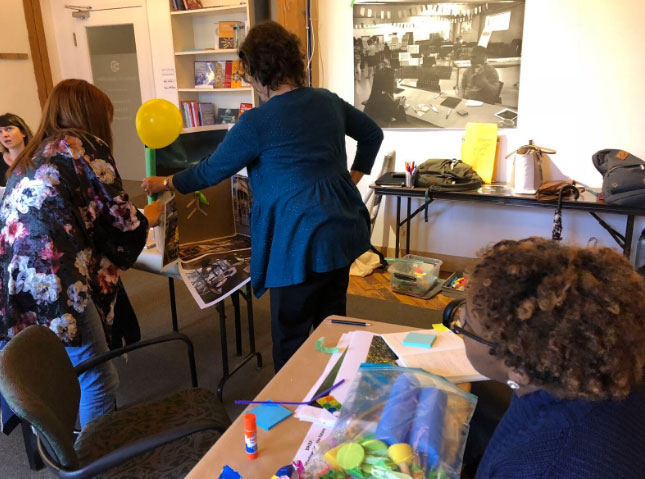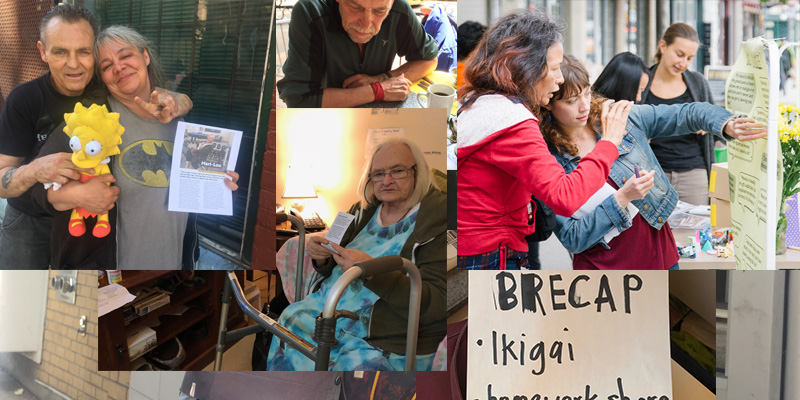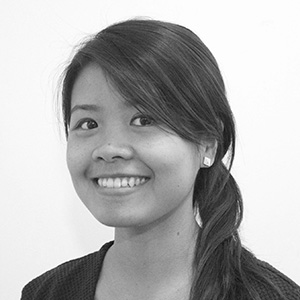Categories
Elizabeth
by Daniela Kraemer
“Will you come again?” is how visits often end. And not surprisingly, for many of the folks we spend time with, particularly the older adults (see our stories from Allies in Aging), this is the deepest conversation they’ve had in days, weeks, months, even years…
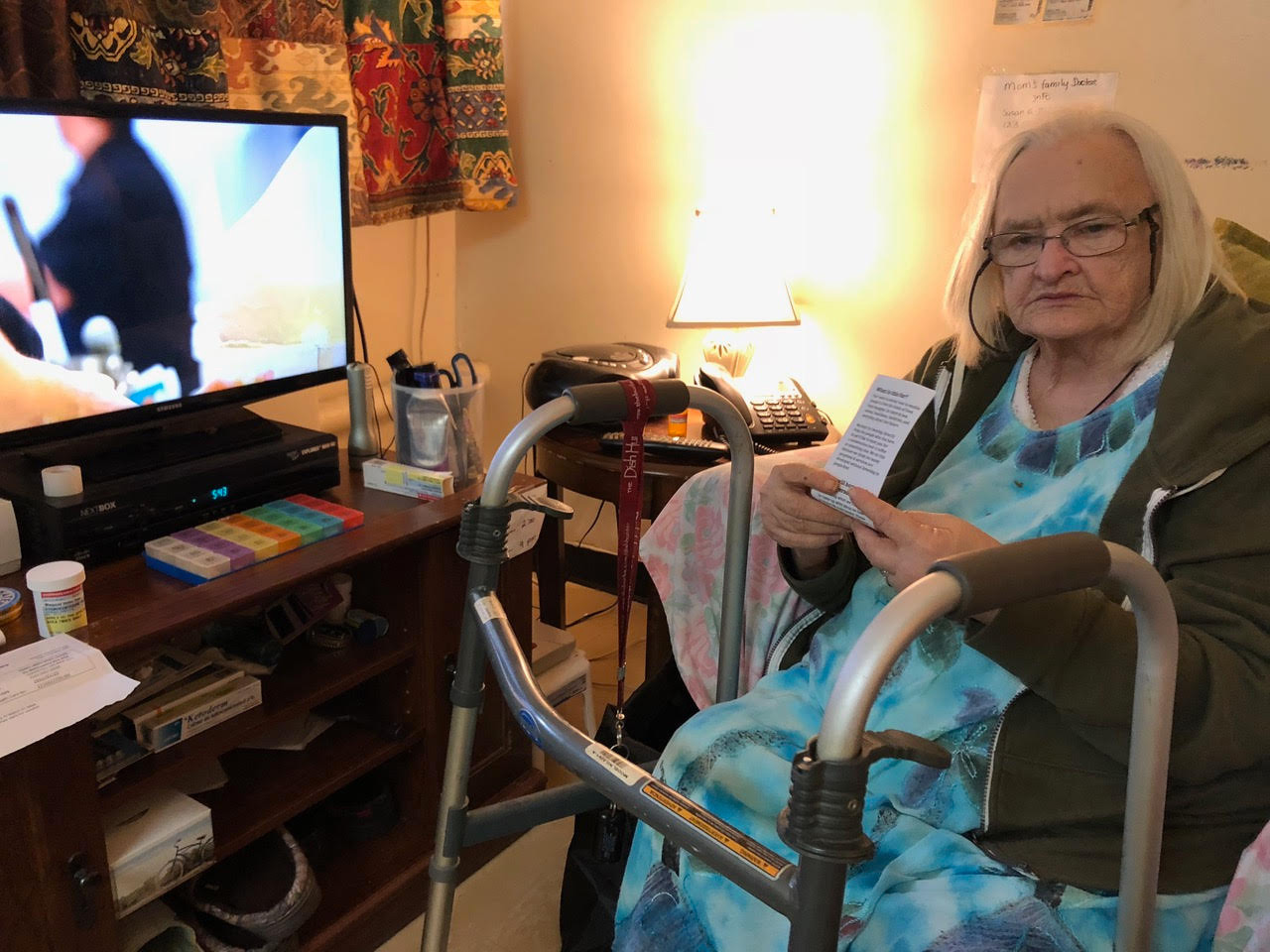
Meet Elizabeth (age 77) living by herself in a basement studio in a social housing complex in downtown Toronto. I first met her while shadowing a personal support worker (PSW) around the building for a couple of hours. The PSW, strapped for time, heated a can of soup for Elizabeth’s lunch, took the garbage out and left. Their total interaction time was 11 minutes and less than a dozen words were said.
Later, when I went back, Elizabeth’s daughter was there taking care of laundry as she does once a week. Her conversation with her mom was functional, further illustrated by the instructions she leaves for the PSWs pasted to the fridge and the wall. Elizabeth also wasn’t engaged, paying more attention to the TV.
This is Elizabeth’s world – few social interactions, and when people do come around they are pragmatic. I spent about 3 hours with Elizabeth in her apartment. The TV was on when I walked in and she was focused on a cooking show. She didn’t pay much attention to my spiel: “I’m here collecting stories about what life is like living in this building”. But as the questions asked her about her values, aspirations, hopes, dreams, sadness, regret, her attention moved from the TV to our conversation.
I observed Elizabeth tapping her feet to salsa music playing in a commercial. “Do you like music” I asked. She responded to my question with a huge smile – “I used to be a dancer, ballet, tap, any type I danced it. I used to perform.”
It was such a subtle movement, anyone not paying attention to her, not interested in what (big or small) makes up her every day, would have missed it. Elizabeth talked about dancing for a while. As she did, her body language changed, she moved more. Her tone changed. She laughed.
When I left Elizabeth a few hours later she was smiling.
Jane and Joe and Jane and Joe...a story of two people in two different relationships – with each other
by Maggie Vilvang
Jane’s a support worker on the job and a fun loving gal the rest of the time. Joe’s a client Jane supports at work and her cocktail drinking, poolside sitting pal the rest of the time.
At work Jane wrote a ‘personal plan’ for Joe that includes goals to go swimming, learn to cook, lose a few pounds. At the end of each work day Jane records Joe’s progress towards goal achievement.
On the weekend, kicking back poolside Jane and Joe chat about everything from their dreams of love to world politics. They muse over how much they love the poolside, but hate actually getting wet. And then they laugh. Joe shows Jane his new App ‘Leave the Dishes’. They toast to the fact that they’ll never cook again and probably put on a few pounds. And then they laugh.
On Monday Jane supports her client named Joe to go swimming. No one laughs.
Work, meaning, and purpose
by Valentina Branada
This week we started a meeting with one of the Grounded Space crews with an exercise that reflects on the balance in your life between what you are passionate about, what you know how to do, what pays you, and what the world needs. These are transcendental questions about meaning and purpose in your life. It was a short activity but everyone opened up and shared a bit about themselves, and a few surprised me by sharing very personal and deep stories. They were vulnerable in front of their co-workers and I felt so grateful and connected with the crew for allowing us to peek into their lives and hearts. This kind of sharing and vulnerability is such a strong human aspect that many times we avoid in the workplace. Especially when we start getting into a routine and are pressured to get things done. Taking a moment to see each other as people reminds us why we are in this kind of work, it is so powerful. It completely set up the tone for the rest of our work session, it brought the team together and we had fun through the process.
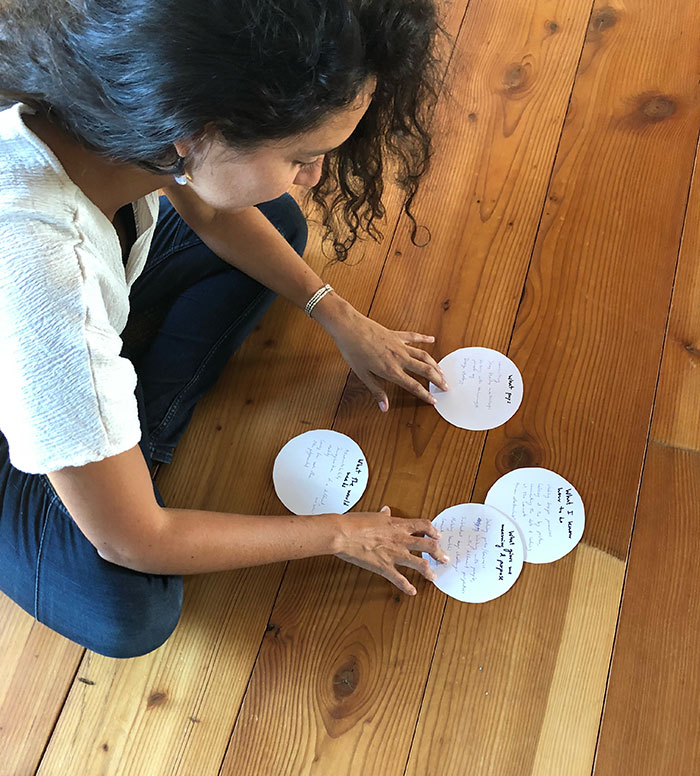
In a Word
by Natalie Napier
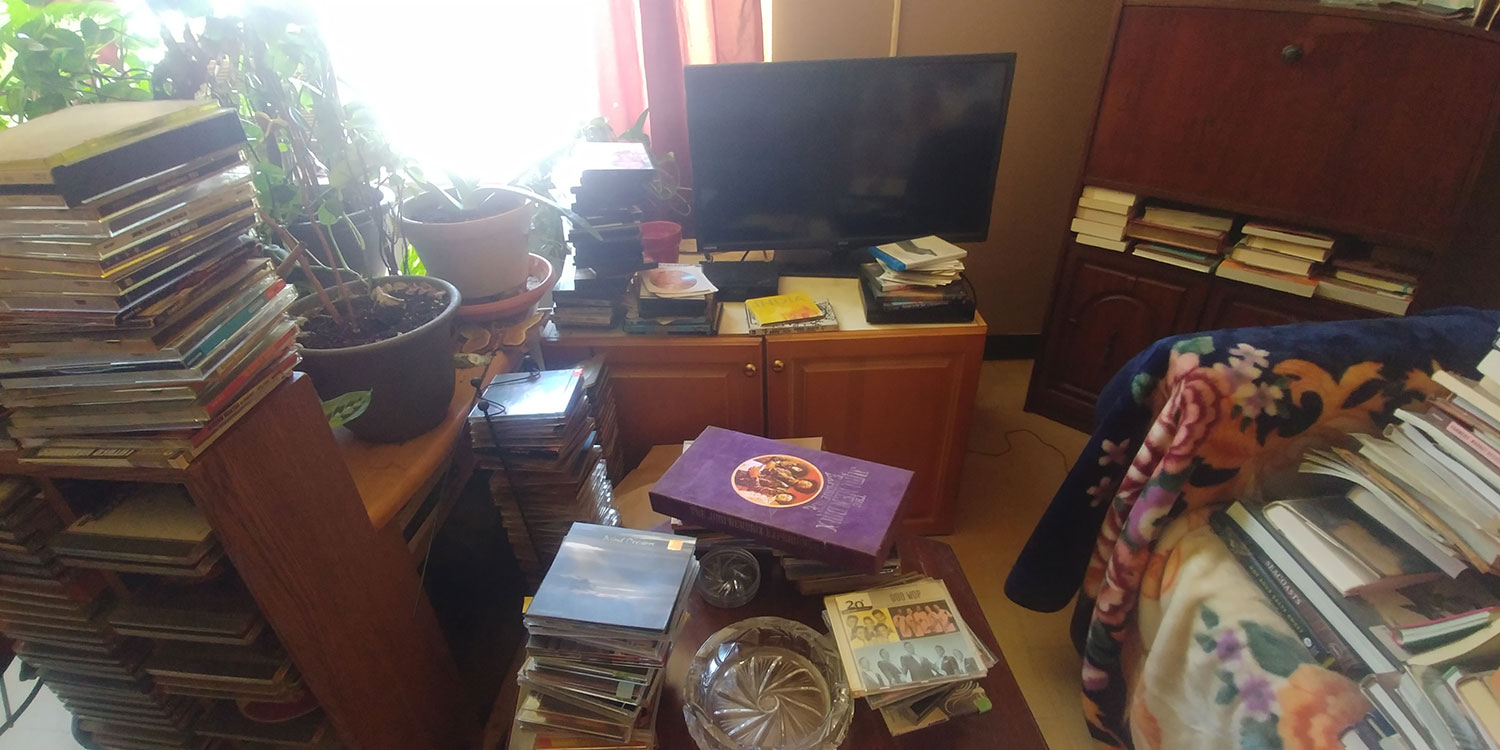
I sat at Sheila’s kitchen table drinking deliciously strong coffee and eating slices of banana bread she’d made. It had cherries in it, but in a really good way. Sheila ate little and chain smoked. Eventually, her boyfriend David joined us and drank beer while Sheila stuck with coffee. David’s Jamaican and Sheila says her neighbour across the hall, who is also Jamaican, helps Sheila cook “proper meals” for him. Sheila and I are talking about what matters in life now, in her mid 70s. I present her with a card that says “Independence,” and Sheila seizes it. “Well, now, I have no doubts about my independence! I know I’m independent because West Neighbourhood House lists me as independent. It’s right on their forms,” she says triumphantly. She reflects that, without David helping with grocery shopping and around the apartment, WheelTrans for trips, and cleaning services, “I’d be helpless.” I walked away thinking about how one little word had conveyed so much validation. Likely her PSWs used it for internal purposes. Because of it, Sheila’s self-efficacy remained intact in the face of increasing reliance on friends and workers.
New Ways, New Places
by Carolyn Camman
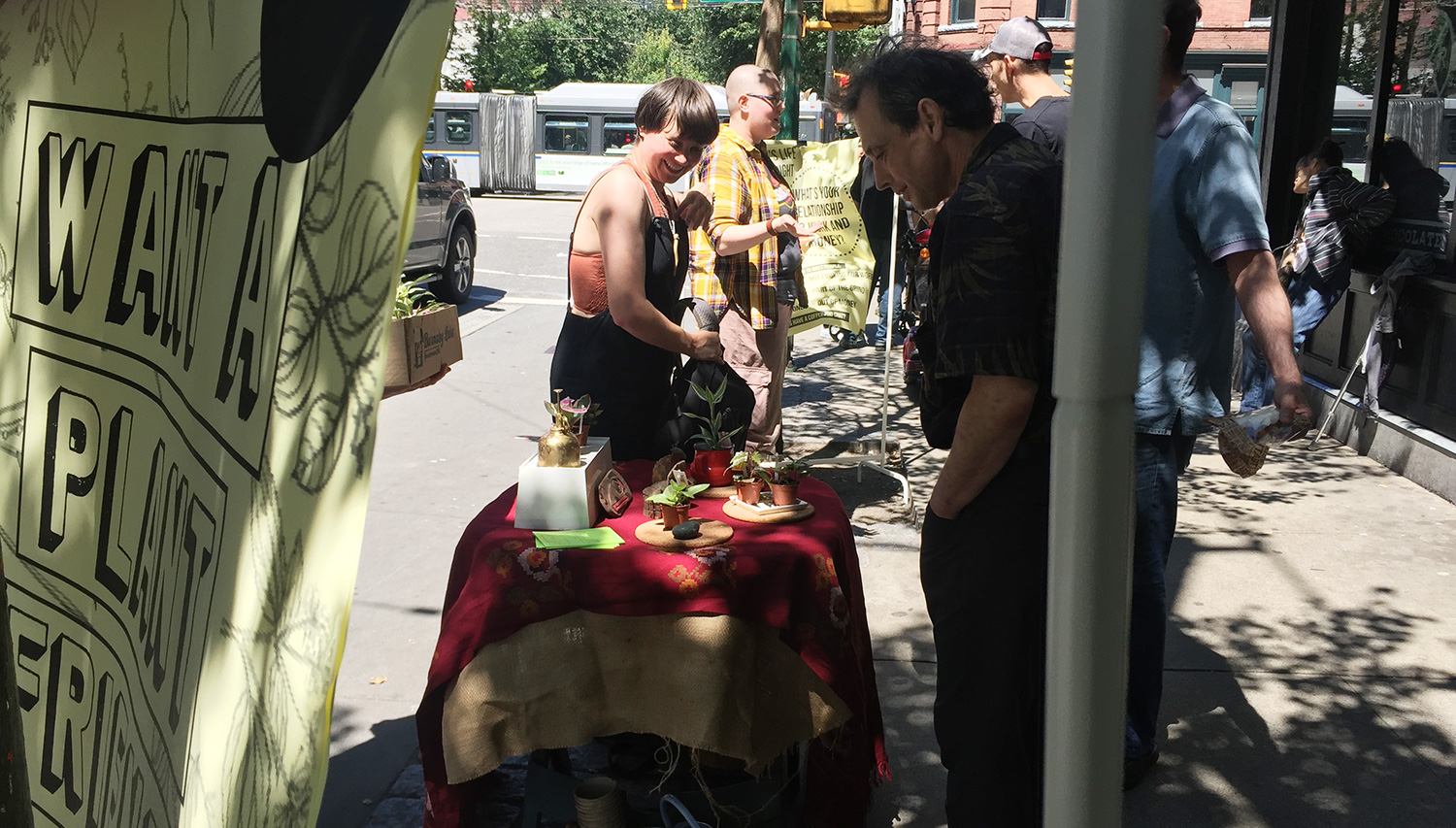
I’m no stranger to seeing the community cohesion of the Downtown Eastside. It’s one of the most sociable places in Vancouver. But it’s a complicated community too, and I’m used to seeing it from the outside, as a passerby or a temporary guest of the neighbourhood. It must be me whose been holding myself as the outsider though, because with the slightest effort—a free plant, the offer of a conversation—I find myself invited in, greeted warmly. Hanging out on the curb in front of the Olivia Skye building with some of our new contacts, I’m introduced to more people in ten minutes than I normally meet in a week. It’s a front porch culture, one missing from so many places I’ve lived, though here the porches are makeshift and subject to disruption by cops, street cleaners, and annoyed business owners. But it’s a good place to be human, surrounded by other humans. The exhilaration of it makes me want to come down here every week, with plants and lemonade to exchange for stories and connections.
Woodchips
by Gabi Matey
I sat down next to a woodcarver in Gastown. People in Downtown Eastside call him Woodchips. His little corner by a parking lot was decorated with an indigenous style woodcarving of a fist with an extended up middle finger. I told Woodchips how I tried woodcarving the week before and just ended up injuring my hand.
After I complimented a picture of a wing sculpture on his phone, he took out a new piece of wood and walked me through his technique. We shared a watermelon and stories. One of my favourite stories was how when Woodchips and his crew used to hang out by Sunset beach, somebody from the nearby building kept on calling the cops on them every day. The cops would come. Seeing that no harm was being done, and impressed by Woodchips’ art, the cops would often purchase his woodwork.
Our Mothers' Watches
by Muryani Kasdani

Ken came into Embers Eastside Works and asked for “the people who ran the lemonade stand the other day.” I told him that would be our team. We were hanging out in Downtown Eastside in Vancouver to meet folks and have a chat about work and money as part of our Quick Dive research project with Embers Eastside Works.
Ken and I headed to The Old Spaghetti Factory to have a chat. I showed him a tool that we designed based on the Japanese Ikigai framework and asked for his feedback. “Well, what brings me meaning and purpose is my mom, not work and money…” Ken said to me. What’s on offer though, is minimum wage construction work that he doesn’t enjoy or find meaningful and strains his back.
He then pointed to his watch, one of the few things he still has after being robbed a few days ago while sleeping on the streets and said “Look, I got this from my mom. It doesn’t work, but I wear it because it reminds me of her.” I was surprised and I pulled out my watch and said “Oh, I also got this watch from my mom! It doesn’t work either, because I need to replace the battery!” When we finished lunch, we walked together to Chinatown where Ken pointed to me a place to get a new battery for my watch and then he said “Thank you, it was really nice talking to you.”
Kool-Aid Bliss
by Anna Bond
So here’s the thing, I don’t identify with letters before or after my name, I’ve never won an award for any design efforts and I speak quite a different language than my Social Science and Design counter-parts… so how do I find myself drinking the IWF Kool-Aid so to speak? It’s a question I’ve pondered many times myself, but truth be told I wouldn’t want to be anywhere else.
Never before in my varied career have I witnessed such a tenacious pursuit for a ‘new world’ based on inclusion, respect and growth grounded in real lived experiences and stories. Coming from a quantitative world of ROI’s, I’m not used to being exposed to the value of non-traditional measures that make up value and fulfillment. More often than not, success is measured by the bottom line versus intrinsic shifts in the human paradigm. When we start questioning the social norms of what’s expected, against what’s actually needed, it raises many curious questions. All of which deserve to be further discussed and explored.
One of my favourite IWF human interactions is having the privilege to bear witness to the essence of Sarah. Never before have I a met someone as honest, humble and committed as her. The IWF movement on Grounded Space and Grounded Data, it just that – a Grounding and affirmation of how things should be. Whilst most others are motivated by ego, status and financial gain, Sarah is driven by an unbridled force to equalize a disconnected world, which has strayed from its axis. Her intentionality for this pursuit is nothing less of magical.
So there you have it. I’m an unlikely participant in the IWF world but here I stand. While I may have acute skills to offer the Operational side of things, my reward on this adventure is the opportunity to be part of a culture where conventional notions are constantly being evaluated, interpreted and synthesized. Where evolution is the name of the game. There’s plenty of Kool-Aid on offer – you should have a glass.
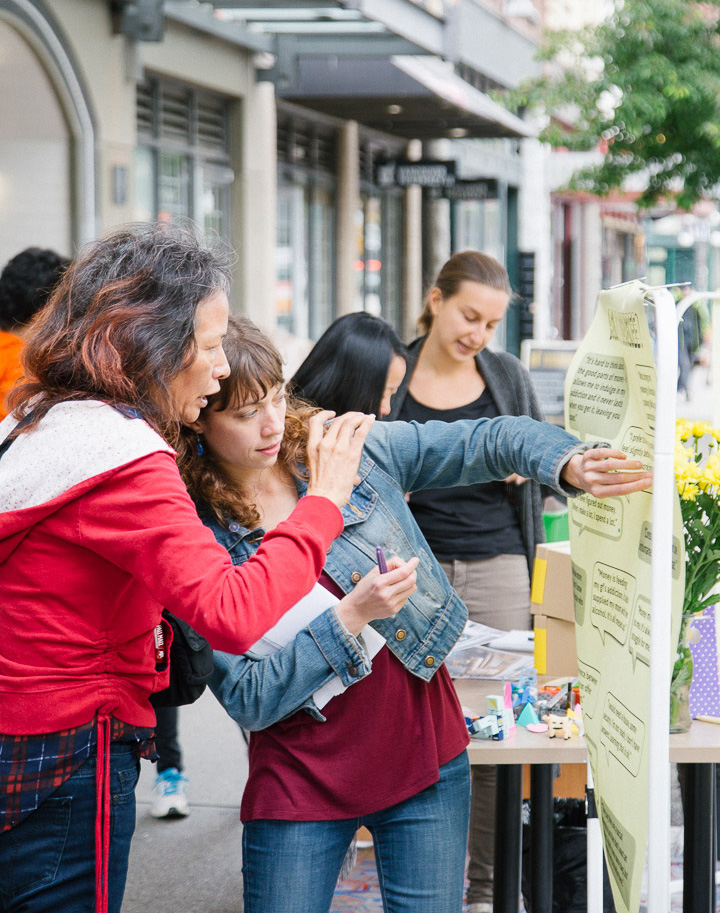
Ripples in a Pond
by Melanie Camman
More than once I have heard Sarah say that the ethnography is an intervention in itself. In my experience so far, I agree, but I think the impact goes beyond just the person being interviewed. Being truly listened to is empowering, as my experience with Mari-Lou exemplifies.
Mari-Lou and a few others spent a lot of time out on that block of sidewalk, and so we got pretty familiar, everyday there be a moment or two to chat and say hello, continuing to get to know each other. I enjoyed that part of the process. It was during the next phase that I struggled, writing has never been easy or enjoyable for me, but I had the responsibility to honour the stories people had shared with me, in a literary sense I had peoples lives in my hands.
The truly gratifying moment was returning those stories to the people we had met. It was a hot day, so Mari-Lou wanted to meet at West Hotel for a beer, and because it was air conditioned. “It’ a drunks bar,” said Mari-Lou. Read what you want into this, but I enjoyed the atmosphere, and I wondered to myself, what if services could be conducted in a place like this — a classic InWithForward musing. I presented Mari-Lou her story as her friend Steven cracked a can of Bud and filled my glass under the table. I looked up as Mari-Lou began to weep, “oh honey, I needed this. Things haven’t gone so well the last few weeks, and oh, I can’t believe how good I look on paper. The only thing I could think while I was reading is that someone else sees me this way. You know you make me feel really valued. Here Steven I can’t right now.” Mari-Lou took a moment to soak it in, and passed it to her friend. To our surprise, in a moment Steven was weeping. “Oh you got her, you got her.” Steven was one of her first friends when she arrived in the shelter over three years ago. “I found her you know,” he used to bring her weed to help with her back pain, he knows all about her previous partner, her worries about her son, her habit of giving all her cigarettes away to make others feel better. He’s been the one there to give her a cigarette after her pack’s been emptied. We stepped outside for a smoke and a photo. As we sat outside Steven wrote a note in my sketchbook about Mari-Lou:
Mari-Lou is a mother to everyone downtown she gives her love free + helps + protects everyone freely and with respect!! She would give her soul for the ones she loves! I am so proud and happy she has a place and a stable living accommodation that she is happy now. Thank yous to all the team members who have helped in any + all ways. Thank-yous! Love Steven Kerry.
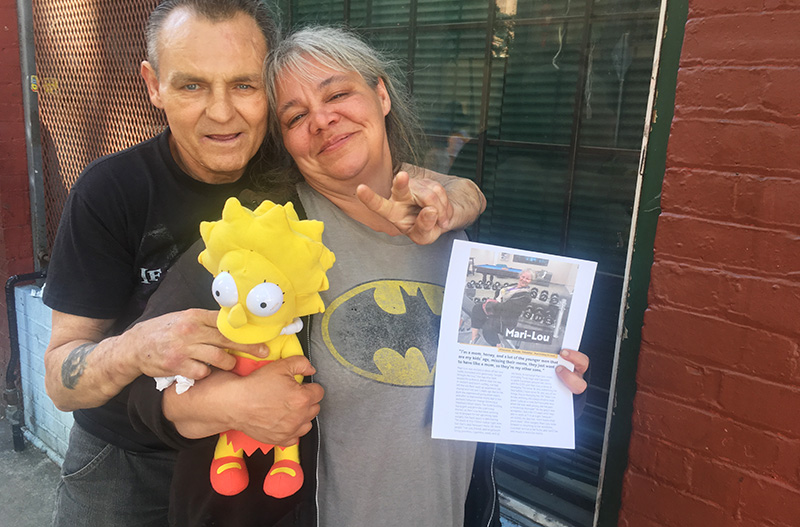
On that first day we spent over 3 hours together as Mari-Lou shared her story. Being listened to had a positive impact on that day. In returning Mari-Lou’s story she felt a sense of validation, and with the paper print of her story she has a source of validation, an artifact to revisit. Her, Steven and myself found the experience cathartic, each for our own reasons. It is my hope that the impact continues to ripple out, that by sharing stories like Mari-Lou’s with people in service organizations, and society at large, we can begin to shift our approach to how social services are conceptualized and delivered, rooting them in moments of human interaction. I met Mari-Lou at a pivotal moment in her life, one that would be easy to overlook. There is opportunity in the simple sidewalk conversation to create an interaction that elevates.
The Big Shift
by Marie-Eve Bélanger
There have been so many beautiful human moments with the West Neighbourhood House Grounded Space team. Perhaps one of my recent favourite would be when all the Embedded Researchers and Culture Curator joined forces to create a diorama that would represent the future of Employment Services. This activity served as a first introduction to prototyping and generating ideas while making (instead of talking!). From puzzlement and apprehension to a child-like excitement and wonder, we ran through the full gamut of emotion in a short 30 minutes. In that short time span, each of them shifted from a social science and research mode to a generative design approach, which, while uncomfortable at first, was almost second nature to each of them as they started to handle, modify and shape images, cardboard, modelling clay, and pipe cleaners. Being able to witness their excitement at the quality and richness of the ideas they were able to surface, as well as how they were able to quickly get to a shared understanding of this vision (and all the while learning the ropes of design) was priceless.
